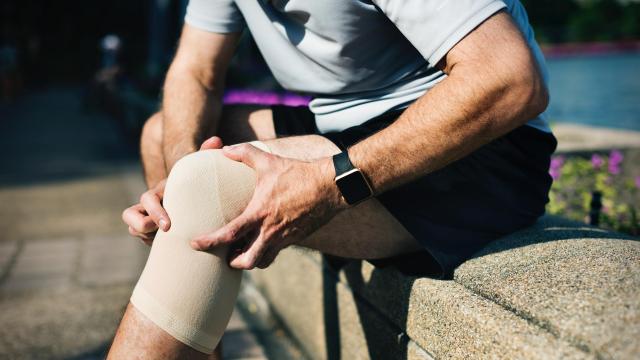Ever come from a session at the gym feeling especially sore?
When you’re nagged by a lingering soreness in your shoulder or stiffness in your lower back, it’s important to look out for a couple of warning signs in order to determine if it’s a regular post-workout ache or something far worse.
I spoke to Blake Dircksen, a doctor of physical therapy at Bespoke Treatments and creator of Nightcap Training, about the red flags of soreness, why taking a rest isn’t always a good thing, and why you might finally need to book that appointment with a PT you’ve but putting off for months now. Before you test an injury and render yourself incapable of going to the gym at all, look out for these signs.
Pain that lasts longer than 72 hours
Yes, it sounds obvious, but if you worked out three days ago and are still feeling like a noodle, that’s actual cause for concern. According to Dircksen, if it hasn’t been 72 hours, you might be fine — especially if you’re new to the gym or trying a new lift.
[referenced url=”https://www.lifehacker.com.au/2019/02/what-to-do-about-your-sore-muscles/” thumb=”https://i.kinja-img.com/gawker-media/image/upload/t_ku-large/nscrtpxsogigdnkr7k1o.jpg” title=”What To Do About Your Sore Muscles” excerpt=”So you worked hard at the gym yesterday, and you’re feeling it now. You have a case of DOMS (delayed onset muscle soreness) and you just want it to stop. Here’s how to cope, and importantly, how not to.”]
“If you’re doing something new for the first time or working in a range of motion you haven’t worked in — say you’re squatting a little lower or you’re [lifting] overhead for the first time in a long time — then you can expect to be a little sore,” he said. “It’s called delayed onset muscle soreness and [it] lasts anywhere from 24 to 48 hours, sometimes 72 hours, if you’ve really pushed it and it exceeded your limitations.”
However, DOMS should decrease over time, once you’ve become accustomed to a move or routine. If you’ve seen little improvement after three days, you’ll want to reach out to a physical therapist or doctor, he said.
Swelling is also a bad sign. Any swelling means your body is sending inflammatory elements to your injury, so take heed!
What to do: If you’re sore for more than three days, talk to a doctor. Anything less and you might just be suffering from the pangs of a new gym routine.
Pain that’s acute and sudden
Say you’re at the gym feeling great and a wrong move suddenly makes your wrist, lower back, or shoulder feel immediately off. Well, that’s another good reason to see a doctor, especially if you’ve pulled or strained a muscle, says Dircksen.
“You can still take a day or two break,” he said. “Or if it’s not debilitating, just finish the workout and modify [it] so that’s not going to irritate it any more. You’d want to be more cautious.”
According to Self, localised pain is also something to note. If you’re noticing a very specific pain somewhere on your body, and not a general soreness across a muscle, that may be a reason to proceed with caution, too.
What to do: Take a day off. If you’re not in agonizing pain, you might be fine. If working out is unbearable, however, see a doctor ASAP.
Pain that radiates
Ever experience a “soreness” that seems like it’s radiating or throbbing? That may be a bad sign. Dircksen advises that pain radiating down the arm or the leg is called ‘radicular pain.’
“It means the nervous system is involved,” he says. “So pain shooting down the arm means there’s some kind of compression of the nerves.”
A pinched nerve, for instance, can result in radicular pain.
What to do: Dircksen recommends scaling back your workout (less weight, fewer reps, etc.).
Don’t take a break from the gym
Contrary to what most of us are led to believe (that rest cures all), Dircksen often recommends staying in the gym and working out as you normally would to the best of your ability, as long as it’s not causing pain.
“The problem is that if you’ve taken off a full week off from doing any sort of physical activity, for that whole week, you have de-conditioned your [body] and now you’re in a weaker spot than when you started,” he said. “When you’re weaker, you’re going to be more vulnerable to further injury. So you’ve entered this negative spin cycle of inactivity.”
Instead, keep active, scale back, and use ice and heat whenever necessary, Dircksen said. And when all else fails, just book that physical therapy appointment already — better safe than sorry.
This article has been updated since its original publish date.

Comments